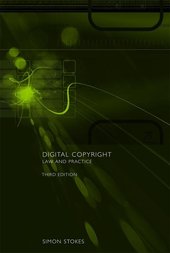BOOK REVIEW
DIGITAL COPYRIGHT:
LAW AND PRACTICE
By Simon Stokes
Oxford and Portland, OR: Hart Publishing, third
edition, 2009,
229 pp, ISBN 978-1841139326, £35.00.
Download options |
 |
|
DOI:
10.2966/scrip.060309.774 |
||
This book by Simon Stokes is an updated edition of Digital copyright: law and practice. As its title reveals, the book is about challenges to copyright in the digital age. It aims at providing help to copyright creators, owners, businesses, users and their lawyers through the maze of copyright and other related rights.
Up-to-date developments of copyright law, database law, moral rights, E-commerce and the correlation between digital rights and competition law are considered effectively. Furthermore, this edition is extended to include some current issues which are the results of expanded bandwidth and Internet access. An additional chapter is provided to deal with issues concerning user-generated content, Web 2.0 and beyond. Also, the most significant and relevant reported cases from the UK, the EU and the US are mentioned and discussed next to each considered issue. In addition, a revision of the topic of copyright policy and management is included which takes into consideration the most recent developments in the field of copyright exploitation and licensing.
The book attempts to identify and defeat problems of digital copyright in a brief and simplified way. The approach of the book tends to give an overview and general practical guidance on each of the identified dilemmas of digital copyright and related issues.
The book deals with the several aspects of digital copyright through nine chapters. In the first chapter, the author introduces digital copyright generally by shading the light on the digital challenges to copyright and discussing the future of copyright in the digital environment. Also, this chapter draws a concise framework for the international characteristic of copyright and its links to technology and other IP rights. Chapter two demonstrates the basic legal rules that govern digital copyright in the UK and which is built upon the analogue copyright represented in the Copyright, Designs and Patents Act 1988. Moreover, this chapter highlights some issues following the implementation of the Digital Copyright Directive and Electronic Commerce Directive into UK copyright law.
Chapter three of the book deals with the correlation between copyright law and database right. It explains both copyright and database right protection of digital databases. It gives simple and brief analysis of the law on theses issues in addition to discussing the most important cases. Finally, it gives practical suggestions to help the makers and owners of these rights.
Digital moral rights are dealt with in chapter four. This chapter explains the meaning of digital moral rights and gives an overview of these rights and how they are infringed. Also, it gives a practical guide on dealing with digital moral rights in practice. The correlation between digital rights and competition law is considered in chapter five which reveals both the UK and EU competition laws. In chapter six, the author discusses the subject of copyright protection of computer programs or software under the Copyright, Designs and Patents Act 1988 and the Software Directive. Furthermore, this chapter explains the Open Source movement as way of licensing software and its potential challenges to copyright. Chapter seven examines the relationship between digital copyright and electronic commerce “e-business”. It discusses several topics in this field and reveals some practical issues. Chapter eight considers some copyright issues resulting from the growing use of the internet such as user-generated content, Web 2.0 and beyond. It explains how fair dealing is applied to these issues and examines the liability for hosting and distributing user-generated content on the internet. The last chapter deals with practical issues of creating, exploiting and licensing digital copyrights. It also looks at the role of collecting societies and it provides precedent checklists which are helpful for both copyright owners and users.
In conclusion, this is a welcome new edition of the book. Even though it is in fact brief on some issues that need further discussion, it provides rich food for thought. Digital copyright: law and practice presents a handy, well written and informative framework for the considered subject. It is a helpful book and recommended reading for anyone interested in digital copyright. It will also be a valuable guide to anyone seeking an introduction to and practical guidance on the mysterious world of copyright in the digital age. The book can be highly recommended to IP owners, users, lawyers and students.
Ghufran Sukkaryeh
PhD candidate, School of Law, University of Edinburgh.
© Ghufran Sukkaryeh 2009

This work is licenced under a Creative Commons Licence.
Please click on the link to read the
terms and conditions.

